HMML Palimpsest Project
HMML Palimpsest Project
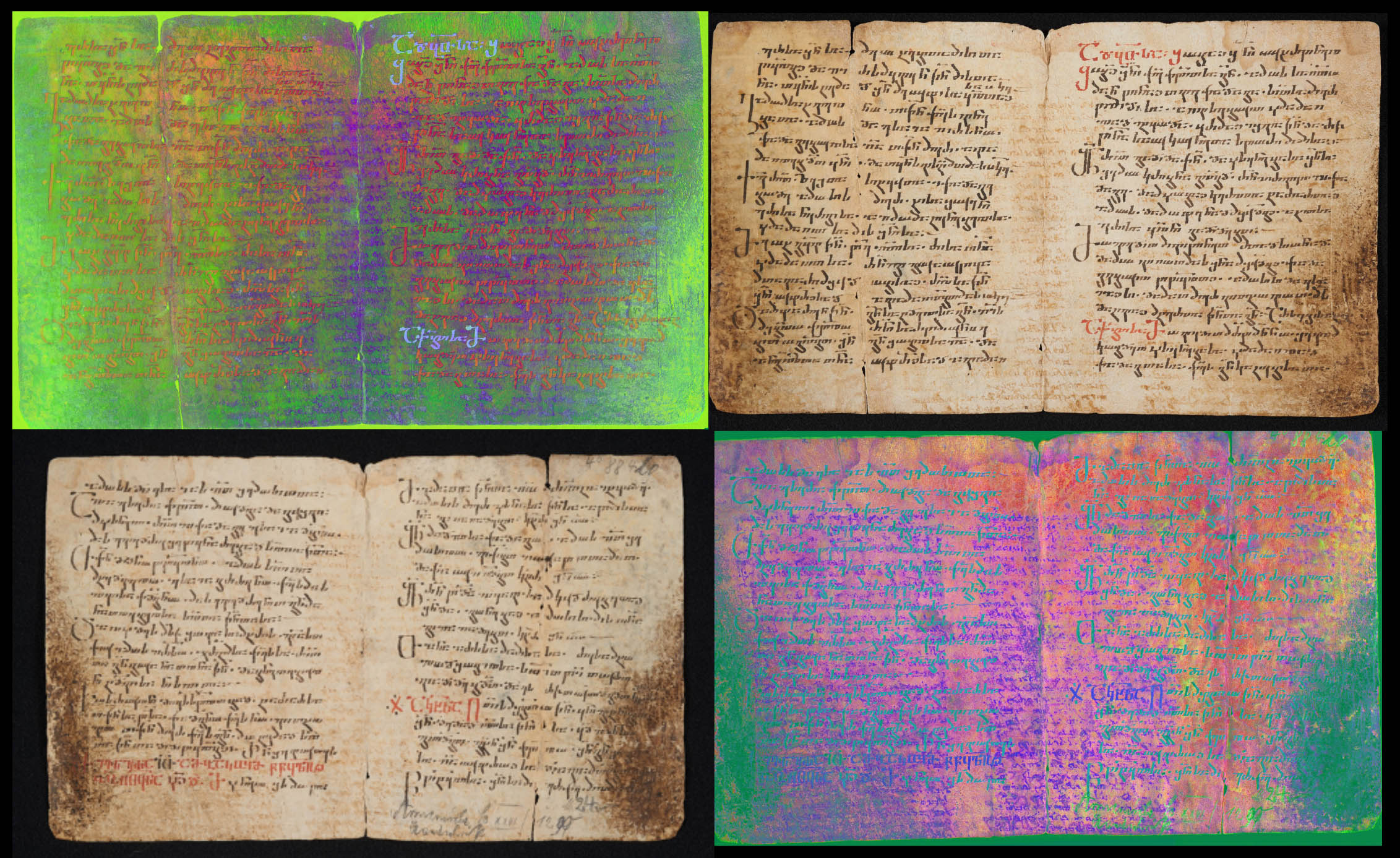
About
History of the HMML Palimpsest
The HMML Palimpsest Project focuses on the history, scientific imaging, and research of a medieval parchment bifolium, SJU Ms Frag 32, in the Special Collections of the Hill Museum & Manuscript Library. A palimpsest is a parchment manuscript whose writing has been mechanically scraped or chemically scrubbed, so that the parchment sheet can be reused for a new text. This was not an uncommon practice in certain places and periods during the Middle Ages, when parchment – an expensive sheet material – was in demand for use in creating new texts.
Discovery Timeline
- 2017 An undertext is discovered by Matthew Z. Heintzelman, HMML Curator of Western Collections and Rare Books, while handling the leaf in preparation for an exhibition on manuscript fragments. He shares it with HMML Executive Director, Dr. Columba Stewart, a Syriac scholar, who notes that the faint trace of writing in the center of the bifolium appears to be early Syriac. The discoveries continued to unfold. The visible upper text, erroneously labelled as 17th-century Armenian, is in fact from a 10th-century Georgian liturgical manuscript.
- 2018 The upper text is identified by Georgian scholars Natia Dundua and Cici Guledani as a chant containing part of the liturgical services for Saint Amos (June 17) and Saint Habakkuk (June 19). Transcription here.
- 2020 Scholar Stig R. Frøyshov (University of Oslo) suggests the Georgian upper text is written by scribe Iovane Zosime in the 950s, early in his scribal career working at the monastery of the Great Lavra of St. Sabas. Frøyshov also notes that the leaf is part of a larger manuscript copied by Zosime, now in the library at Saint Catherine’s Monastery on Mount Sinai, Egypt (MS Sinai Georgian 49). (The palimpsests at Saint Catherine’s have been imaged for the Sinai Palimpsest Project.) In September 2020, Grigory Kessel identified the earlier Syriac undertext as being from Matthew 13:49-50, and the later Syriac undertext as being from Theodoret of Cyrrhus's History of the monks of Syria. The portion on the HMML fragment is from chapter 4, on the monk Eusebius of Teleda. Although other portions of Theodoret's work were already known in Syriac, the HMML fragment is the first known Syriac witness to this portion of the text. In addition, Grigory discovered that two other manuscripts held in European libraries contain portions of the same manuscript, including both the Georgian overtext and the two Syriac undertexts. These other manuscripts are held by the Vatican Library (manuscript Vat. iber. 4) and the Bibliothèque nationale de France (manuscript Géorgien 30).
Imaging Timeline
- 2018 With the suggested early date of the Syriac text, the palimpsest becomes a good candidate for imaging using multispectral imaging (MSI). HMML partners with Mike B. Toth, of RB Toth Associates, to image the leaf. The resulting image data do not provide enough information to read the text, though it does reveal that there were, in fact, two layers of Syriac underwriting embedded in the parchment, thereby making it a “double palimpsest.” Both Syriac undertexts are parallel to the Georgian upper text, making the imaging, digital processing, and reading difficult (palimpsests often have texts running perpendicular to one another, making them easier to differentiate).
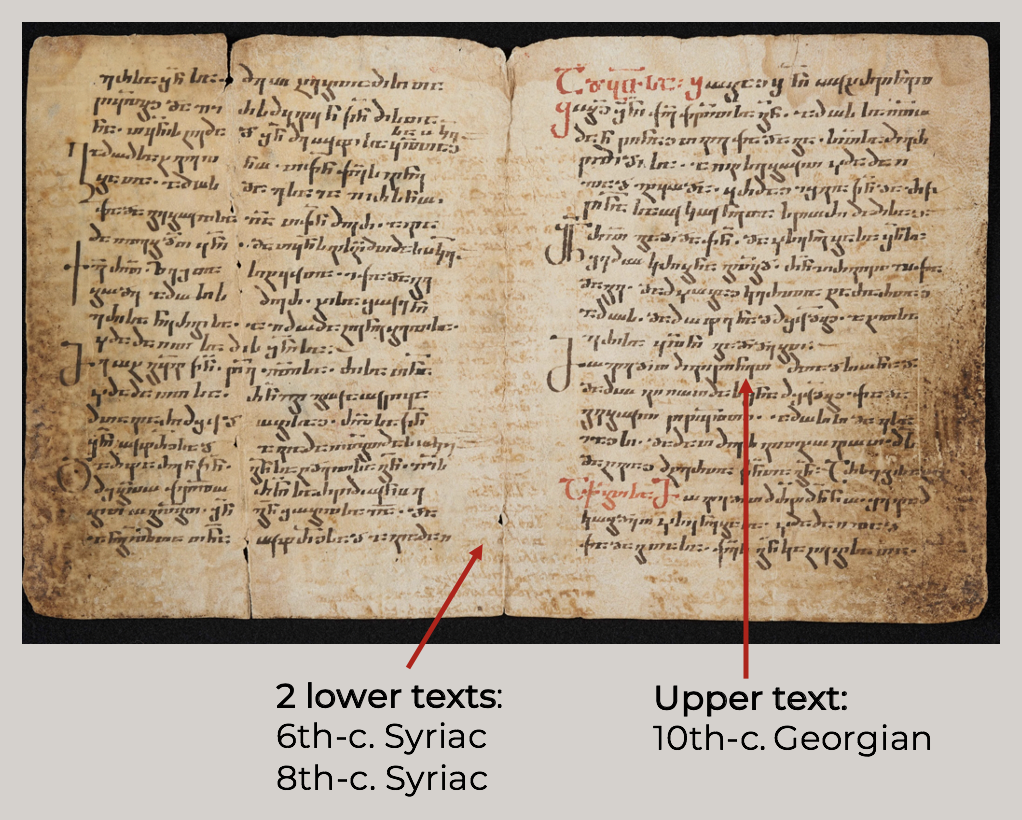
- 2020 With this exciting discovery of a second layer of undertext, Toth proposes sending the palimpsest to Stanford University’s SLAC National Accelerator Laboratory for x-ray fluorescence (XRF) imaging at the Synchrotron Radiation Lightsource. The HMML team agrees that this may allow for a deeper imaging of the text and the palimpsest is sent to SLAC in January. Preliminary results, reviewed by HMML Curator for Eastern Christian Manuscripts, David Calabro, suggest an early date for the oldest layer of text - possibly as early as the late 6th century, putting it in a rare and small group of known surviving Syriac texts.
Advanced Imaging Technology
Advanced imaging technology has been used for over two decades to read hidden texts within parchment manuscripts. The early pioneering work in the field was carried out by an international team of data scientists, imaging experts, and manuscript scholars, who came together to image the now famous Archimedes Palimpsest, found to contain lost mathematical treatises of ancient Greek mathematician Archimedes. More recently, imaging was carried out on the Syriac Galen Palimpsest, that revealed the scrubbed off text of Sergius of Resh 'Ayno's Syriac translation of ancient physician Galen's Greek pharmacological treatise, "On Simple Drugs." Each project enhances the application of advanced imaging for manuscript studies and the HMML Palimpsest Project builds on these earlier imaging experiments, furthering technology in the field.
Multispectral Imaging
Narrowband multispectral imaging is often the first technology applied to imaging a palimpsest. This non-destructive technique projects multiple narrow wavelengths of light onto the sheet - ranging from ultraviolet through the visible and infrared - visually amplifying compounds found in inks, pigments, and residue. The resulting data, which captures this response, must be processed to produce images and adjusted to enhance specific areas of text. For texts that are sitting well below the surface of the parchment or are obscured by other elements, XRF imaging may be required to image them. This was the case with the HMML Palimpsest, which has a coating of calcium on the surface that made MSI imaging difficult. Early Syriac manuscripts often have calcium present, and these experiments will improve the knowledge of how to image palimpsests from this tradition.
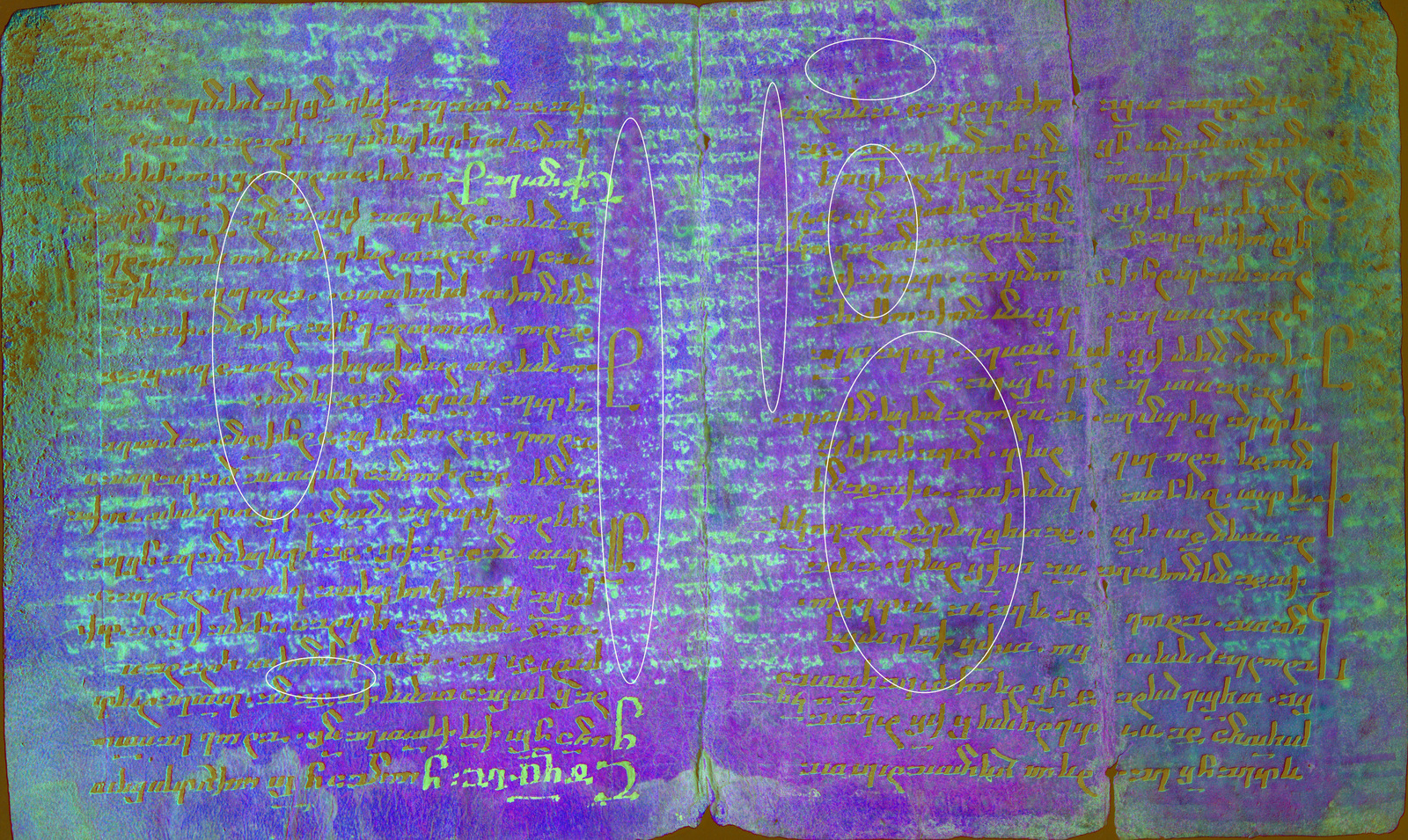
X-ray Fluorescence Imaging
X-ray fluorescence (XRF) imaging provides non-destructive elemental analysis, using a high-powered x-ray source to cause elements in an object to emit x-ray energy. This response is captured and mapped to identify elements found embedded within the sheet, such as the iron, zinc, and copper that can be found in iron-gall ink. With XRF, the metals in inks can be isolated from the calcium in the sheet, and this differentiation produces more detailed data and imagery.
The Synchrotron Radiation Lightsource (SSRL) at Stanford’s SLAC National Accelerator Laboratory is one of a few places in the world where this imaging is performed. Similar to the MSI process, raw data must be processed to produce images. For the HMML Palimpsest, the research team will use SMAK processing software (an acronym that stands for SSRL data scientist Sam Webb's Microprobe Analysis Kit). The software puts data manipulation into the hands of scholars, so they can process images themselves, enhance, reduce, and refine certain elements for better analysis of the hidden texts.
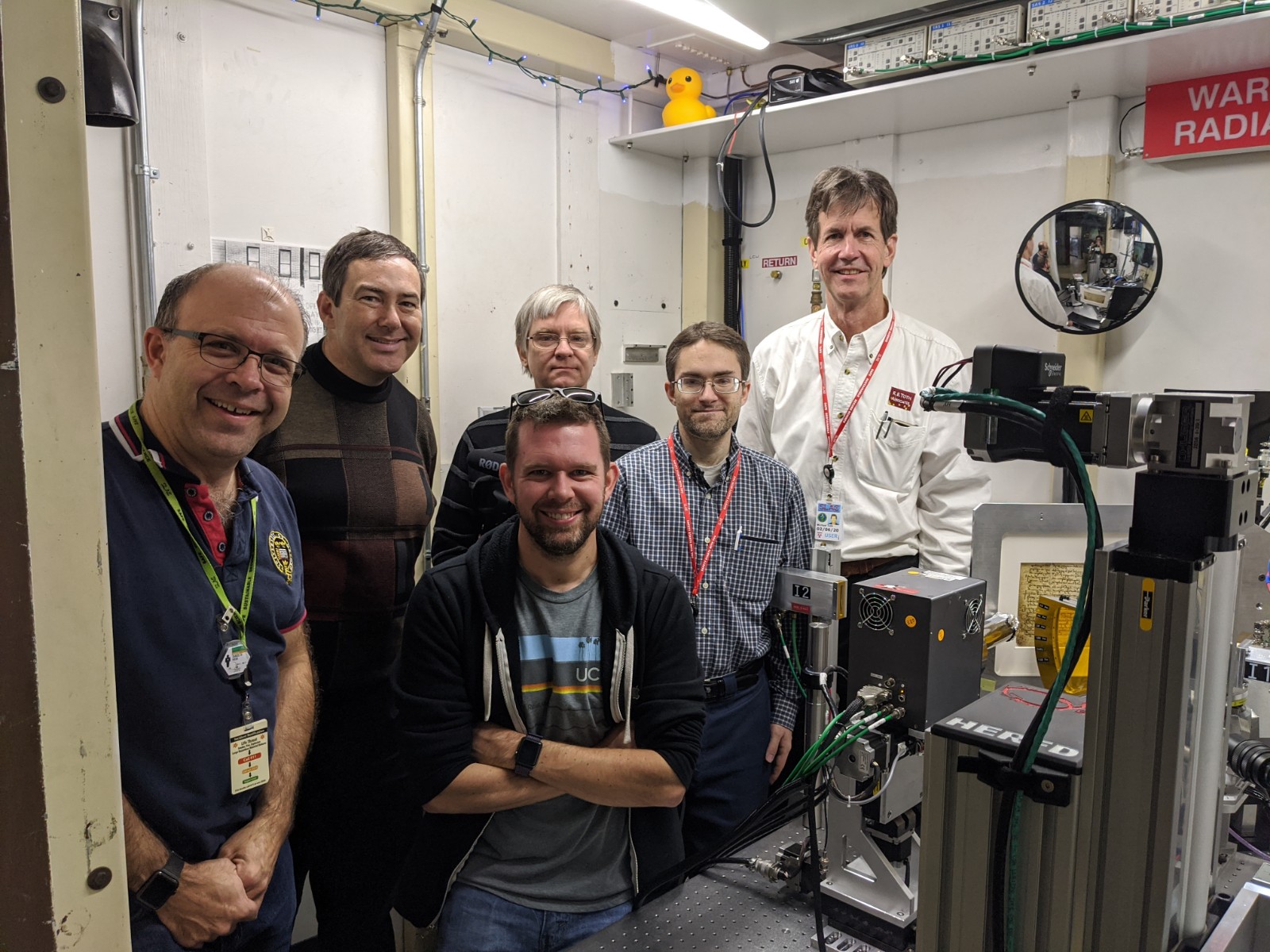
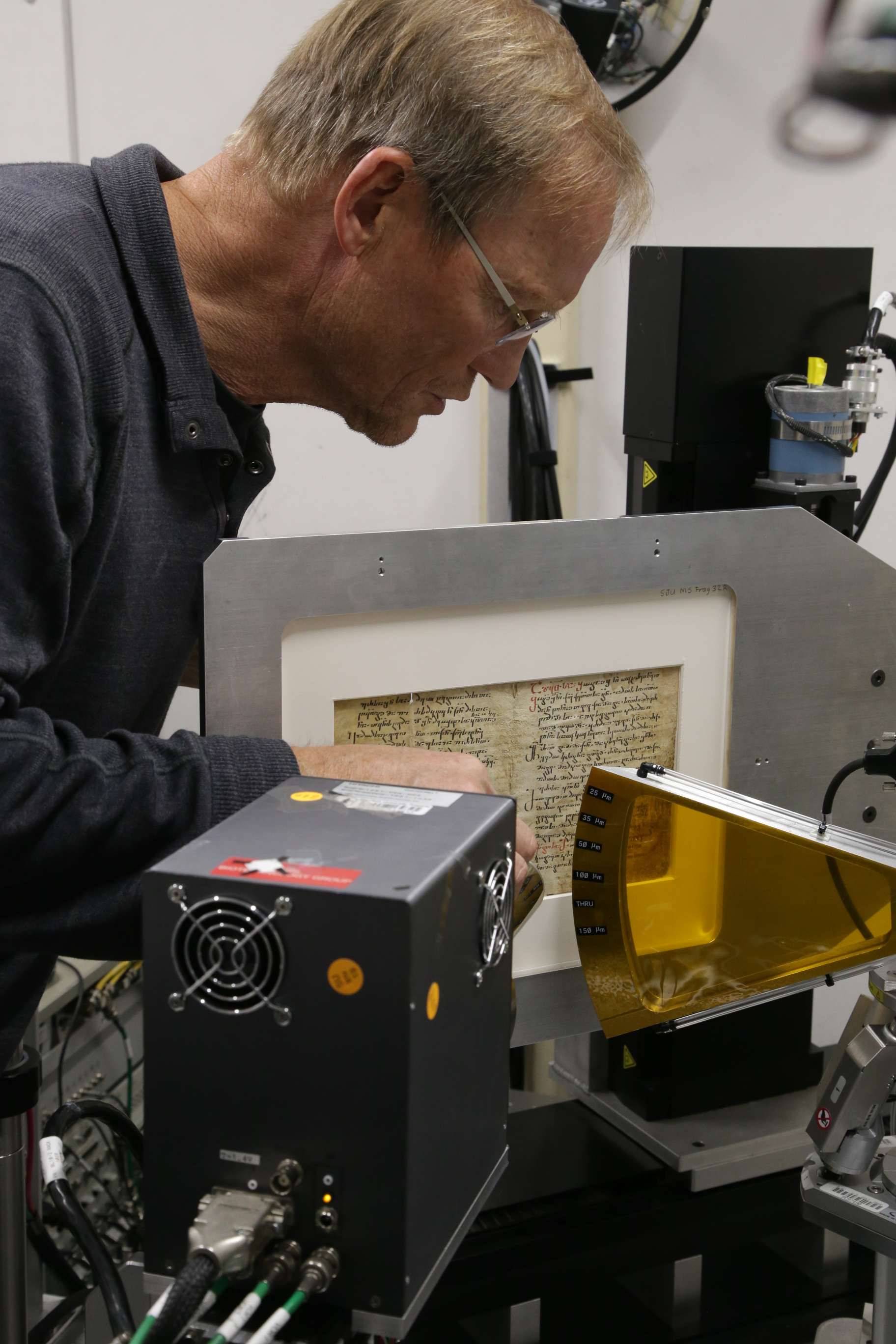
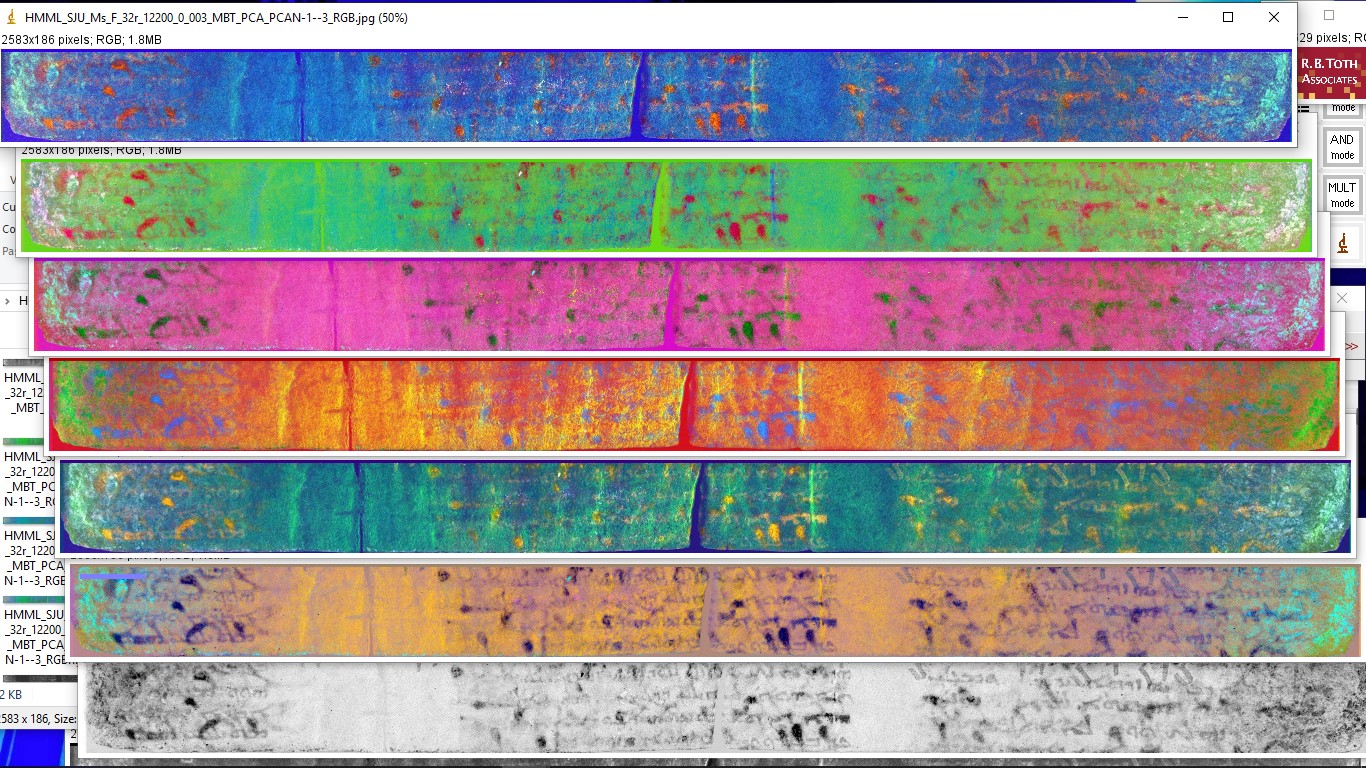
Images and Data
Data Management and Open Access
HMML’s mandate is to provide open access advanced imaging data and images of the palimpsest in both raw and processed formats, to make them available to as many users as possible. Because of the complexity and amount of data produced by the project, HMML partnered with the Schoenberg Institute of Manuscript Studies (SIMS) at the University of Pennsylvania, to host the advanced imaging data on its repository, OPenn. At SIMS, the HMML palimpsest joins the famed Archimedes and Syriac Galen palimpsests on the OPenn site. Natural light images and four processed images of the palimpsest are available for viewing on HMML Reading Room.
Research
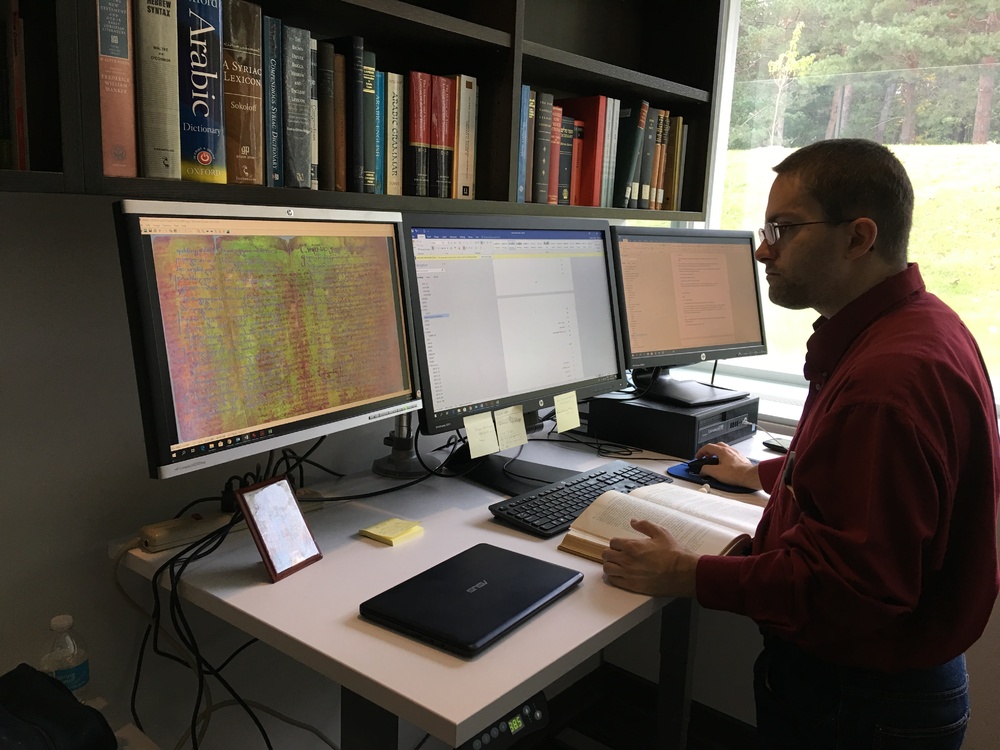
Research and Discovery
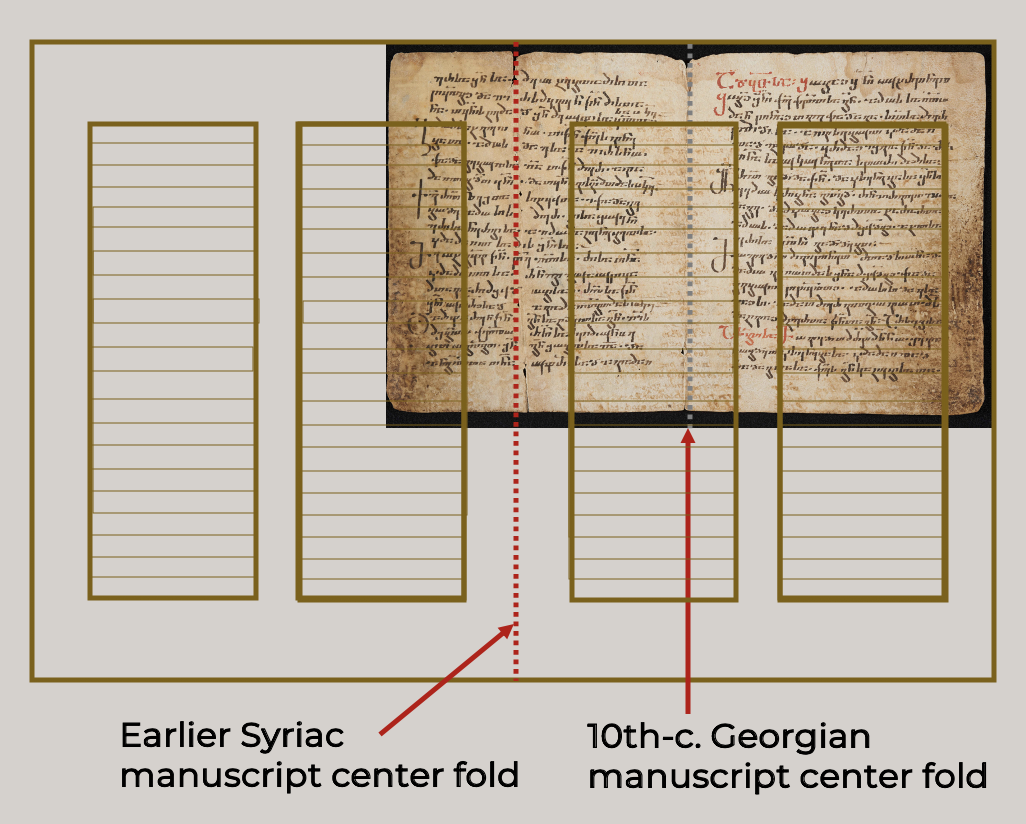
Even without imaging, basic codicological analysis can offer clues about the size and layout of the original manuscript, how it may have been used, and by whom. The later Georgian manuscript leaves were cut out of a larger Syriac manuscript, almost double the size. As the diagram illustrates, the fold lines and undertext of the palimpsest allows scholars to recreate the layout and size of the earlier Syriac manuscript with which the palimpsest shared its covers. Though the existing palimpsest is small, by reconstructing the column width and length, it is possible to determine that it actually came from a much larger manuscript. Size is often related to genre, and the dimensions of the manuscript may point to the original Syriac manuscript being designed for liturgical use. The large size of the Syriac letters in the earlier undertext supports this possibility. In any case, the ongoing codicological and textual analysis offers a rich array of information about the production and use of books by religious communities in the premodern Near East.
Stay tuned for more discoveries.
Publications
Grigory Kessel, “Membra disjecta sinaitica iii: Two (Palimpsest) Fragments of Sin. geo. 49 and Their Four Syriac Undertexts” in The Vatican Library Review, 2022, pp. 257-270.
M. B. Toth, W. A. Christens-Barry, D. Calabro, M. Z. Heintzelman, M. Moreton, C. Stewart, “Integrating Advanced Imaging of Ancient Manuscripts” in The Proceedings of Conference of the Society for Imaging Science and Technology, 7-21 May, 2020, pp. 33-38.
Melissa Moreton, “The HMML Palimpsest Project” in Manuscript Studies, Winter 2020.
News
Teams and Acknowledgements
Project Management
- HMML: Dr. Melissa Moreton
- RB Toth Associates: Mike B. Toth
Multispectral Imaging Team
- RB Toth Associates: Mike B. Toth
- Equipoise Imaging LLC: William A. Christens-Barry
- University College London: Cerys Jones, PhD candidate
XRF Imaging Team
- HMML: Dr. David Calabro, Dr. Matthew Z. Heintzelman, Tim Ternes, and Wayne Torborg
- RB Toth Associates: Mike B. Toth
- SLAC National Accelerator Laboratory/ Stanford Synchrotron Radiation Lightsource: Dr. Uwe Bergmann, Dr. Nicholas P. Edwards, Dr. Sam M. Webb, Beam Operators, and other staff (The Stanford Synchrotron Radiation Lightsource and SLAC National Accelerator Laboratory generously provided beam time for XRF imaging. The use of SLAC/ SSRL is supported by the US Department of Energy, Office of Science, Office of Basic Energy Sciences, under contract no. DE-AC02-76SF00515.)
- Stanford University Libraries: Kristen St. John
Research Team
- HMML: Dr. David Calabro, Dr. Grigory Kessel, Dr. Columba Stewart, Dr. James Walters
Data Management Team
- RB Toth Associates: Mike B. Toth
- Schoenberg Institute for Manuscript Studies: Jessie Dummer, Doug Emery, and Lynn Ransom
Contact Dr. Josh Mugler, Curator of Eastern Christian & Islamic Manuscripts
